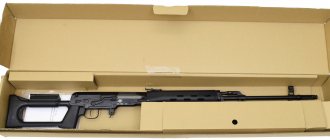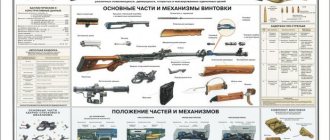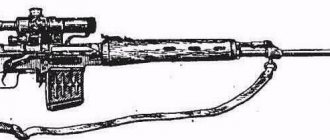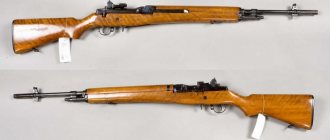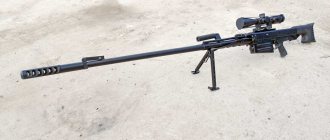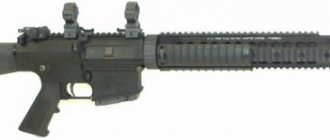History of the Dragunov Sniper Rifle
The Dragunov rifle was created back in the last century. Officially, it was assigned the GRAU index - 6B1. This indicator characterizes the device as a self-loading device with a caliber of 7.62. It was developed specifically for snipers, so it has an optical sight, allows you to hit the enemy at a long distance and has a high accuracy rate. Development took place over five years.
The structure was completely ready in the spring of 1963. Already in the summer of the same year, the government approved mass production and the rifles entered service with the Soviet Army. It’s worth starting to get acquainted with this legendary weapon with the historical facts that preceded its creation. Already in the 30s, the armed forces of the USSR began to pay increased attention to rifle training of military personnel. That is, before giving the order to create the most accurate rifle, the military leaders decided to start training and improving the skills of shooters.
This decision bore fruit during the Great Patriotic War, when Russian snipers were able to change the course of the war several times thanks to their skills. Based on the training, a number of requirements for new types of weapons were developed. The military was able to establish that over a short distance, many more aimed shots can be fired from an automatic weapon. Increased performance combined with accuracy formed the basis of the future rifle. This is exactly the result that was expected from the designers who perfectly implemented the idea and created the SVD.
The craftsmen took as a basis several designs at once, on the basis of which a unique configuration was then created. Some projects were completely closed due to the fact that it was proposed to create a very complex mechanism that would make it difficult to use, clean and disassemble weapons in the future. Only at the end of 1958 was the final configuration of the rifle approved. As a result, SVD is a combination of the work of many specialists and a combination of several design programs. The rifle was named after Dragunov because it was this man who headed the last project.
Only thanks to the brilliant mind of the entire team, the drawings were brought to life. There were three design groups in total. The company that will produce sniper rifles was chosen through a competition. The winner was Izhevsk Arms Plant No. 74. They snatched victory from the Klimovsky OKB-180 and the Kovrovsky OKB-575. More than half a century has passed since that time, but the SVD is still considered an indispensable weapon in Russia’s arsenal, just like the Kalashnikov assault rifle.
Combat use
Despite the fact that the rifle began to enter service in the 60s, it was not reported anywhere until the outbreak of hostilities in Afghanistan. After the collapse of the USSR, the rifle was used in many local conflicts in Asia, the Middle East and Africa.
Today, the 7.62 mm Dragunov sniper rifle is in service with the Russian army and the armies of several dozen countries.
SVD structure
The rifle has a lot of design features. This is due to the fact that during the design, the designers tried to take the best from the main projects. Initially, the SVD completely repeated the features of sports equipment, but further improvements made the weapon unique in its kind. The technologies used to create the device were not used anywhere else. Main nuances of the structure:
- The SVD is very similar to the Kalashnikov assault rifle, especially in its internal structure.
- In order for the gun to be ready to fire, the piston interacts with the bolt carrier via a pushrod through the bolt carrier.
- The mass of moving parts is less due to the fact that there are no additional parts in the design of the trigger mechanism.
- The rifling in the barrel initially had a pitch of 320 mm, which guaranteed high accuracy. Then they cut more often. The 240 mm notch distance allowed for a significant increase in accuracy, provided that armor-piercing incendiary ammunition was used.
- When a person pulls the trigger, the firing pin is struck, causing the cartridge capsule to deform. The capsule ignites and the gunpowder begins to burn. The gases that form in the barrel cause the bullet to fly out with incredible power.
When the magazine is already in the barrel, it is enough to move the bolt group to cock the hammer. When the bolt returns to its original position, ammunition exits the magazine and enters the chamber. After this, the return spring is activated. It is pushed by the bolt frame. The bolt locks the bore and the bullet is guided along the rifling, ready to be fired. The bolt rests against the breech of the barrel, and the bolt frame continues to move.
In simple words: a shot occurs due to the high pressure that is created due to the burning of gunpowder. The mechanism is designed in such a way that the only moving part in the entire system is the ammunition, which pushes the accumulation of gases. In a fraction of a second, the bullet passes the section of the barrel to the holes for removing the powder gases and then there is a direct impact on the gas piston.
The bolt carrier begins to move, pushing and turning the bolt. Then the channel is repulsed, through which the ammunition will fly at a speed of 830 m/s. After the bullet leaves, the bolt frame returns to its original position and the channel closes. The cartridge case is removed, the hammer is automatically cocked, that is, the weapon is again ready to fire. By pressing the trigger again, another shot is fired. This action can be continued until the magazine is used up.
All the actions described above are carried out in a matter of seconds, after the hammer is cocked and the trigger is pulled.
Firing accuracy
In accordance with the “Manual on Shooting,” the accuracy of a rifle is considered normal if, when firing four shots from a prone position at a distance of 100 m, all four holes fit into a circle with a diameter of 8 cm. Shooting is carried out with cartridges taken from a hermetically sealed container from the same batch with ordinary bullets with steel core.
Initially, the SVD was produced with a rifling pitch of 320 mm, similar to sporting weapons and ensuring high accuracy of fire, however, when the Dragunov sniper rifle was put into service, it turned out that with this pitch the dispersion of the B-32 armor-piercing incendiary bullets doubles. As a result, it was decided to change the rifling pitch to 240 mm, which led to an increase in the dispersion standard at a distance of 100 m from 8 cm to 10 cm (which, however, was not reflected in the NSD). When firing with a 7N1 sniper cartridge, the dispersion is (depending on the pitch of the rifling) no more than 10-12 cm at a distance of 300 m.
The direct shot range of the Dragunov SVD sniper rifle is:
- according to the head figure, height 30 cm - 350 m,
- according to the chest figure, height 50 cm - 430 m,
- according to a running figure, 150 cm high - 640 m.
The PSO-1 sight is designed for shooting up to 1300 meters, but at such a range you can only effectively shoot at a group target, or conduct harassing fire.
The main difficulty when shooting at long ranges is the errors in preparing the initial data for shooting (this is true for all sniper rifles). At a range of 600 meters, the median error in height (in determining the range equal to 0.1% of the range) is 63 cm, the median error in the lateral direction (determining crosswind speed equal to 1.5 m/s) is 43 cm. For comparison, The median deviation of bullet dispersion for the best snipers for 600 m is 9.4 cm in height, 8.8 cm in lateral direction.
Good sniper training allows you to conduct targeted fire even at targets such as helicopters and low-speed aircraft. For example, there is a known case when a fighter of the FMLN partisan detachment managed to shoot down a jet attack aircraft of the El Salvadoran Air Force with a shot from an SVD. This happened on November 12, 1989 near the village of San Miguel. The Cessna A-37B aircraft coming into the attack successfully fit into the sight and was hit (later the successful sniper said that he was aiming at the cockpit). The bullet hit the pilot, after which the plane lost control and crashed. Iraqi militants used SVD in a similar way, claiming to have destroyed RQ-11 Raven small reconnaissance UAVs with sniper rifle fire.
Advantages and disadvantages of the model
An analysis of the advantages and disadvantages will allow you to understand how this rifle behaves in action. Review of pros and cons:
Advantages and disadvantages
Self-loading mechanism
Ease of use, simplicity
Maintainability and attractive shape, borrowed from sports equipment
Strength. Only high-quality materials are used for creation
Reliability. In SVD speech there are jams or misfires. Can be used even in difficult climatic conditions
High price
Weapons only for sharp shooters (professionals)
Not everyone likes the caliber of cartridges
A negative factor when shooting is the moral acceleration of the cartridge
Disassembly and cleaning require special skills. The mechanism is complex, so it is difficult for a beginner to disassemble it
During weapon operation, ammunition is supplied from a box magazine, which is attached at the bottom, opposite the sight.
SVD equipment
Upon purchase, a person receives a whole set. In addition to the rifle, a detachable sight and ammunition are supplied. Additionally, the set includes a bayonet-knife. A certificate and passport must also be attached. If the documents are not prepared by the Izhevsk plant, it means that the device is an analogue and its technical characteristics may differ. The product is delivered in a plastic case. A flash suppressor must be attached to the front of the barrel. It has five notches. It helps the shooter remain undetected at night and protects the device from contamination. There is a gas regulator that allows you to adjust the rollback speed of the moving parts. This greatly simplifies operation and increases the reliability of the device.
Additionally, the shooter can purchase a tactical suppressor/flash suppressor. It is produced in a limited edition.
Disassembling the Dragunov sniper rifle
There is partial and complete disassembly. In order to clean the weapon, it is not necessary to completely disassemble it. In order to begin the process, the site for this event should be prepared. Algorithm for incomplete disassembly:
- Rent a store. Check to see if there is a cartridge in the chamber.
- Remove the optical sight. Then lift the clamp screw handle and turn it to the side. Pull the safety down.
- Pull the charging handle back, then lower it. Move the sight back and separate it from the receiver.
- Remove the butt cheek. Then the loop is removed from the hook of the clip and the cheek is separated.
- Remove the receiver cover. The latch is removed from the return mechanism.
- Remove the bolt carrier and bolt. This is done with pressure. The frame must be lifted to properly separate from the receiver.
- The trigger mechanism is removed. To do this, it is necessary for it to take a vertical position.
- Then the barrel linings are removed. First, the contactor is rotated and then removed from the ring cutout.
- The gas piston is removed. It is important to perform this action with pressure, lifting the part up.
- Removing the pusher with the spring. When the removal is successful, the person gains access to the internal mechanism, which periodically requires maintenance.
If a person is not a professional, then disassembly should be carried out strictly according to the instructions and the parts should be laid out in order, so as not to get confused later during assembly. After cleaning the rifle, it is assembled in a similar manner.
ASG SVD-S - the best option for beginners
The ASG SVD-S is an “entry” level rifle, but with a reliable trigger mechanism.
The shot speed is low - only 95 meters per second, caliber - 8 millimeters. The descent is not adjustable, but the bullet clearly maintains its trajectory in flight. At a distance of up to 40 meters, it allows you to accurately hit a target even without proper shooting skills and the use of pneumatic weapons.
The rifle is characterized by its low weight, since its design uses a plastic stock. In “combat” condition it has a length of 1100 millimeters (barrel - 550 millimeters). The advantages of the ASG SVD-S are the presence of an adjustable hop-up, the ability to install an additional sight for an air rifle, and a very capacious magazine (200 balls). We invite you to watch the video of US sniper rifles below. Read about how to purchase a PCP 6.35 rifle without a license here.
ASG SVD-S
Those shooters who have already tested the ASG SVD-S complain about its poor weight balancing, as well as the inconvenient location of the safety (manual). But all this is compensated by the reliability and fairly low cost of the model (about 8 thousand rubles).


